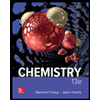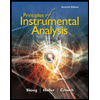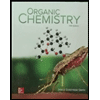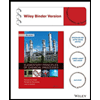
EBK GENERAL CHEMISTRY: THE ESSENTIAL CO
7th Edition
ISBN: 9780100257047
Author: Chang
Publisher: YUZU
expand_more
expand_more
format_list_bulleted
Concept explainers
Question
Chapter 4, Problem 4.82QP
Interpretation Introduction
Interpretation:
The dimming of light, when addition of Barium hydroxide
Concept introduction:
Conductivity of water:
- Pure water is bad conductor of electricity but the ions present in it will conduct the electricity.
- The electrical conductivity of water is increased by increasing ions.
Precipitation reaction:
- If precipitate is formed, when two solutions are mixed together is known precipitation reaction.
Expert Solution & Answer
Want to see the full answer?
Check out a sample textbook solution
Students have asked these similar questions
Hello, I need help with my pre-lab! We are doing a buffer solution in lab for tomorrow and were assigned 3 pH values to create. Mine were pH= 4.50 7.80 9.90
We have to perform, 1 Titration buffer, 1 solid/solution buffer, and 1 solution/solution buffer. I need help with finding out which acids to use, how much, which base to use and how much.
A chemical engineer is studying the two reactions shown in the table below.
In each case, she fills a reaction vessel with some mixture of the reactants and products at a constant temperature of 70.0 °C and constant total pressure.
Then, she measures the reaction enthalpy AH and reaction entropy AS of the first reaction, and the reaction enthalpy AH and reaction free energy AG of the
second reaction. The results of her measurements are shown in the table.
Complete the table. That is, calculate AG for the first reaction and AS for the second. (Round your answer to zero decimal places.) Then, decide whether, under
the conditions the engineer has set up, the reaction is spontaneous, the reverse reaction is spontaneous, or neither forward nor reverse reaction is spontaneous
because the system is at equilibrium.
-
P₁ (s) + 20HF (g). 4PF, (g) + 10H2(g)
AH-1005. kJ
J
AS 2929.
K
AG =
0 kJ
Which is spontaneous?
this reaction
the reverse reaction
neither
AH = 12. kJ
+0=
AS =
SnO2 (s) + 2CO(g) →…
A chemist fills a reaction vessel with 0.281 g silver chromate (Ag₂CrO4) solid, 0.710 M silver (Ag*) aqueous solution, and 0.985 M chromate (CrO2-)
aqueous solution at a temperature of 25.0°C.
Under these conditions, calculate the reaction free energy AG for the following chemical reaction:
Ag2CrO4(s) 2Ag(aq) + CrO4(aq)
Use the thermodynamic information in the ALEKS Data tab. Round your answer to the nearest kilojoule.
4
☐ kJ
x
Chapter 4 Solutions
EBK GENERAL CHEMISTRY: THE ESSENTIAL CO
Ch. 4.1 - Prob. 1RCCh. 4.2 - Practice Exercise Classify the following ionic...Ch. 4.2 - Practice Exercise Predict the precipitate produced...Ch. 4.2 - Prob. 1RCCh. 4.3 - Practice Exercise Classify each of the following...Ch. 4.3 - Prob. 2PECh. 4.3 - Prob. 1RCCh. 4.4 - Practice Exercise Assign oxidation numbers to all...Ch. 4.4 - Prob. 2PECh. 4.4 - Prob. 1RC
Ch. 4.5 - Prob. 1PECh. 4.5 - Prob. 2PECh. 4.5 - Prob. 3PECh. 4.5 - Prob. 1RCCh. 4.6 - Prob. 1PECh. 4.6 - Prob. 1RCCh. 4.6 - Prob. 2PECh. 4.6 - Prob. 3PECh. 4 - Prob. 4.1QPCh. 4 - Prob. 4.2QPCh. 4 - Prob. 4.3QPCh. 4 - 4.4 What is the difference between the following...Ch. 4 - 4.5 Water is an extremely weak electrolyte and...Ch. 4 - Prob. 4.6QPCh. 4 - Prob. 4.7QPCh. 4 - 4.8 Which of the following diagrams best...Ch. 4 - Prob. 4.9QPCh. 4 - Prob. 4.10QPCh. 4 - Prob. 4.11QPCh. 4 - Prob. 4.12QPCh. 4 - Prob. 4.13QPCh. 4 - Prob. 4.14QPCh. 4 - Prob. 4.15QPCh. 4 - Prob. 4.16QPCh. 4 - Prob. 4.17QPCh. 4 - Prob. 4.18QPCh. 4 - Prob. 4.19QPCh. 4 - Prob. 4.20QPCh. 4 - 4.21 Write ionic and net ionic equations for the...Ch. 4 - Prob. 4.22QPCh. 4 - Prob. 4.23QPCh. 4 - Prob. 4.24QPCh. 4 - Prob. 4.25QPCh. 4 - Prob. 4.26QPCh. 4 - Prob. 4.27QPCh. 4 - Prob. 4.28QPCh. 4 - Prob. 4.29QPCh. 4 - Prob. 4.30QPCh. 4 - Prob. 4.31QPCh. 4 - Prob. 4.32QPCh. 4 - Prob. 4.33QPCh. 4 - Prob. 4.34QPCh. 4 - Prob. 4.35QPCh. 4 - Prob. 4.36QPCh. 4 - Prob. 4.37QPCh. 4 - Prob. 4.38QPCh. 4 - 4.39 For the complete redox reactions given here,...Ch. 4 - Prob. 4.40QPCh. 4 - Prob. 4.41QPCh. 4 - Prob. 4.42QPCh. 4 - Prob. 4.43QPCh. 4 - Prob. 4.44QPCh. 4 - Prob. 4.45QPCh. 4 - Prob. 4.46QPCh. 4 - Prob. 4.47QPCh. 4 - Prob. 4.48QPCh. 4 - Prob. 4.49QPCh. 4 - Prob. 4.50QPCh. 4 - Prob. 4.51QPCh. 4 - Prob. 4.52QPCh. 4 - Prob. 4.53QPCh. 4 - Prob. 4.54QPCh. 4 - Prob. 4.55QPCh. 4 - Prob. 4.56QPCh. 4 - Prob. 4.57QPCh. 4 - Prob. 4.58QPCh. 4 - Prob. 4.59QPCh. 4 - Prob. 4.60QPCh. 4 - Prob. 4.61QPCh. 4 - Prob. 4.62QPCh. 4 - Prob. 4.63QPCh. 4 - Prob. 4.64QPCh. 4 - Prob. 4.65QPCh. 4 - Prob. 4.66QPCh. 4 - Prob. 4.67QPCh. 4 - Prob. 4.68QPCh. 4 - Prob. 4.69QPCh. 4 - 4.70 Distilled water must be used in the...Ch. 4 - 4.71 If 30.0 mL of 0.150 M CaCl2 is added to 15.0...Ch. 4 - Prob. 4.72QPCh. 4 - Prob. 4.73QPCh. 4 - Prob. 4.74QPCh. 4 - Prob. 4.75QPCh. 4 - Prob. 4.76QPCh. 4 - Prob. 4.77QPCh. 4 - Prob. 4.78QPCh. 4 - Prob. 4.79QPCh. 4 - Prob. 4.80QPCh. 4 - Prob. 4.81QPCh. 4 - Prob. 4.82QPCh. 4 - Prob. 4.83QPCh. 4 - Prob. 4.84QPCh. 4 - Prob. 4.85QPCh. 4 - Prob. 4.86QPCh. 4 - Prob. 4.87QPCh. 4 - Prob. 4.88QPCh. 4 - Prob. 4.89QPCh. 4 - Prob. 4.90QPCh. 4 - Prob. 4.91QPCh. 4 - Prob. 4.92QPCh. 4 - Prob. 4.93QPCh. 4 - 4.74 The molecular formula of malonic acid is...Ch. 4 - Prob. 4.95QPCh. 4 - Prob. 4.96QPCh. 4 - Prob. 4.97QPCh. 4 - Prob. 4.98QPCh. 4 - Prob. 4.99QPCh. 4 - Prob. 4.100QPCh. 4 - Prob. 4.101QPCh. 4 - Prob. 4.102QPCh. 4 - 4.103 These are common household compounds: table...Ch. 4 - Prob. 4.104QPCh. 4 - Prob. 4.105QPCh. 4 - Prob. 4.106QPCh. 4 - 4.107 A number of metals are involved in redox...Ch. 4 - Prob. 4.108QPCh. 4 - Prob. 4.109QPCh. 4 - Prob. 4.110QPCh. 4 - Prob. 4.111QPCh. 4 - Prob. 4.112QPCh. 4 - Prob. 4.114SPCh. 4 - Prob. 4.115SPCh. 4 - Prob. 4.116SPCh. 4 - Prob. 4.117SPCh. 4 - Prob. 4.118SP
Knowledge Booster
Learn more about
Need a deep-dive on the concept behind this application? Look no further. Learn more about this topic, chemistry and related others by exploring similar questions and additional content below.Similar questions
- Draw the structure corresponding to each IUPAC name. Part 1 of 2 A skeletal structure corresponding to the IUPAC name 3-ethylhexane. Click and drag to start drawing a structure.arrow_forwardUsing any data you can find in the ALEKS Data resource, calculate the equilibrium constant K at 25.0 °C for the following reaction. TiC₁₁(g) + 2H₂O(g) → TiO2 (s) + 4HCl (g) 4 Round your answer to 2 significant digits. K = ☐ x10 D Хarrow_forward: ☐ Х Draw an α amino acid with a hydroxyethyl (-CH2-CH2- OH) side chain. Draw the molecule as it would appear at physiological pH. Click and drag to start drawing a structure. 5 Parrow_forward
- Draw the product of the reaction shown below. Ignore inorganic byproducts. cat. H2SO4 HNO3 (1 equiv) Drawing Qarrow_forwardProvide the correct systematic name for the compound shown here.arrow_forwardUsing the appropriate bond energies, calculate the heat of reaction AH for the following reaction: H-H + CI-CI 2 H-CI You can find a table of bond energies by using the Data button on the ALEKS toolbar. Round your answer to the nearest kJ/mol. Note: For clarity, all lone pairs have been omitted from the molecular structures. ☐ kJ mol ค 000 Ar Barrow_forward
- Predict the hydrocarbon, of formula C6H10, needed to prepare the following geminal dibromide upon treatment with excess hydrobromic acid. Note: The shown product is the only regioisomer formed in this reaction. HBr H₂C. CH3arrow_forwarddraw the major product formed with the listed reagentsarrow_forwardPropose Williamson ether syntheses for the following compoundsarrow_forward
- Identify all functional groupsarrow_forwardA mixture of CaCO3 and MgC2O4 of unknown mass was heated in a 0.5 L closed rigid vessel to 900 degrees C.at 400C the following reaction occurs:MgC2O4 -> MgO (s) + CO (g) + CO2 (g)At 700C a second reaction occurs: CaCO3 -> CaO (s) + CO2 (g)The solid mass in the vessel was measured to be 3.06 g at 400C and 2.03g at 900CQuestion: What is the partial pressure of CO in both temperatures? (400 and 900C), provide detailed explanation.arrow_forwardFor the following alkyne, complete the reaction sequentially (that is draw the intermediate that we can’t stop at) and then name (complete name) all 3 molecules.arrow_forward
arrow_back_ios
SEE MORE QUESTIONS
arrow_forward_ios
Recommended textbooks for you
 ChemistryChemistryISBN:9781305957404Author:Steven S. Zumdahl, Susan A. Zumdahl, Donald J. DeCostePublisher:Cengage Learning
ChemistryChemistryISBN:9781305957404Author:Steven S. Zumdahl, Susan A. Zumdahl, Donald J. DeCostePublisher:Cengage Learning ChemistryChemistryISBN:9781259911156Author:Raymond Chang Dr., Jason Overby ProfessorPublisher:McGraw-Hill Education
ChemistryChemistryISBN:9781259911156Author:Raymond Chang Dr., Jason Overby ProfessorPublisher:McGraw-Hill Education Principles of Instrumental AnalysisChemistryISBN:9781305577213Author:Douglas A. Skoog, F. James Holler, Stanley R. CrouchPublisher:Cengage Learning
Principles of Instrumental AnalysisChemistryISBN:9781305577213Author:Douglas A. Skoog, F. James Holler, Stanley R. CrouchPublisher:Cengage Learning Organic ChemistryChemistryISBN:9780078021558Author:Janice Gorzynski Smith Dr.Publisher:McGraw-Hill Education
Organic ChemistryChemistryISBN:9780078021558Author:Janice Gorzynski Smith Dr.Publisher:McGraw-Hill Education Chemistry: Principles and ReactionsChemistryISBN:9781305079373Author:William L. Masterton, Cecile N. HurleyPublisher:Cengage Learning
Chemistry: Principles and ReactionsChemistryISBN:9781305079373Author:William L. Masterton, Cecile N. HurleyPublisher:Cengage Learning Elementary Principles of Chemical Processes, Bind...ChemistryISBN:9781118431221Author:Richard M. Felder, Ronald W. Rousseau, Lisa G. BullardPublisher:WILEY
Elementary Principles of Chemical Processes, Bind...ChemistryISBN:9781118431221Author:Richard M. Felder, Ronald W. Rousseau, Lisa G. BullardPublisher:WILEY

Chemistry
Chemistry
ISBN:9781305957404
Author:Steven S. Zumdahl, Susan A. Zumdahl, Donald J. DeCoste
Publisher:Cengage Learning

Chemistry
Chemistry
ISBN:9781259911156
Author:Raymond Chang Dr., Jason Overby Professor
Publisher:McGraw-Hill Education

Principles of Instrumental Analysis
Chemistry
ISBN:9781305577213
Author:Douglas A. Skoog, F. James Holler, Stanley R. Crouch
Publisher:Cengage Learning

Organic Chemistry
Chemistry
ISBN:9780078021558
Author:Janice Gorzynski Smith Dr.
Publisher:McGraw-Hill Education

Chemistry: Principles and Reactions
Chemistry
ISBN:9781305079373
Author:William L. Masterton, Cecile N. Hurley
Publisher:Cengage Learning

Elementary Principles of Chemical Processes, Bind...
Chemistry
ISBN:9781118431221
Author:Richard M. Felder, Ronald W. Rousseau, Lisa G. Bullard
Publisher:WILEY
Precipitation Reactions: Crash Course Chemistry #9; Author: Crash Course;https://www.youtube.com/watch?v=IIu16dy3ThI;License: Standard YouTube License, CC-BY